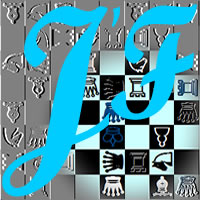
THE AWARD of JULIA’S FAIRIES 2012
(April – December’ 2012)
Judge: N.Shankar Ram
At the outset, my apologies to Julia and all participating composers for the delay in completing this award. Lost some steam in between after starting.. My thanks to Julia for this opportunity.. and to Seetharaman for suggesting my name to her.
Some words about the Julia’s Fairies phenomenon.. Within a short span of time this website has evolved from being a novice composer’s space for publishing her own problems.. to a very professionally managed fairy chess problem resource. Along the way, Julia has also evolved .. as a composer and editor. Of course, her energy and passion is boundless.. and infectious.. as seen in the enthusiastic participation of so many composers.. not only in the originals, but also in the comments and discussion about the published problems. Something heartening is the support and encouragement offered to new composers. Indeed a “miraculously friendly garden” ( Marjan Kovačević )!
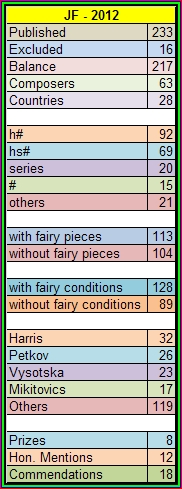
Super GM Petkov has also played an important role.. with his high quality originals.. which he seems to be able to turn out in his sleep..! his detailed analysis and comments on the originals.. his suggested improvements to some of them.. his praise and encouragement for other composers..and his thoughtful and instructive articles.
Coming now to the problems.. For me, the “product mix”, as it were, was something very different from what I had been accustomed to seeing in other magazines, a couple of decades back! There was no neat breakup between directmates, helpmates, selfmates and the like. There was a preponderance of HS#s, neutral pieces as also multiple conditions in the same problem.. in all, quite a heady mix!
The problems of Peter Harris were a particular difficulty for me. I find his style of composition something unusual and new.. to put it lightly! Some of his problems elicited differing reactions from those viewers brave enough to plunge into the details. But, after the initial reaction to “run away screaming”(his own words!), a more careful second look uncovers quite a lot of content.
I had some discussion with Julia regarding options for breaking the whole into sections.. but in the end, decided to take it all together.. Of course, this was a challenging job. The quality of most of the problems was quite high and it was not an easy task for me to select and rank them. The subsequent decision from 2013, to split the year’s originals into 3 separate tourneys was wise.. and better for both the judges and the composers! To conclude, My congratulations to all the composers.. and apologies to those whose problems are not included here.
“In many ways, the work of a critic is easy. We risk very little, yet enjoy a position over those who offer up their work and their selves to our judgement. We thrive on negative criticism, which is fun to write and to read. But the bitter truth we critics must face, is that in the grand scheme of things, the average piece of junk is probably more meaningful than our criticism designating it so. But there are times when a critic truly risks something, and that is in the discovery and defence of the *new*. The world is often unkind to new talent, new creations. The new needs friends…” (Anton Ego in Ratatouille)

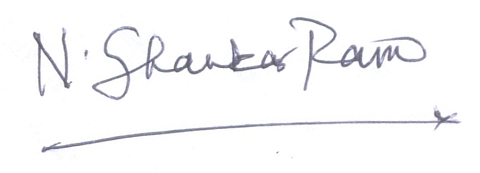 N.Shankar Ram,
N.Shankar Ram,
International master of FIDE
Bangalore, November, 2013.
P RIZES
|
No.125 Jean-Marc Loustau
#2 (14+7) |
No.183 S.K.Balasubramanian & Vlaicu Crișan
hs#4.5 b) BKb4→f6 (4+7)
|
1st-2nd Prize: No.125, Jean-Marc Loustau, France.
A stunning combination of cross checks, white triple grimshaw and lacny themes.. along with rich by-play.. and a double flight giving key to top it off.
The set play shows triple avoidance by “theme A” effects: the black leo closures of the lines g4-d7, g2-d8 and g6-d6 prevent white from closing other lines b5-d7, b4-d8 and b6-d6 to the same squares.
The Key 1.NAg5 changes everything. The original white mates on c6 now return cyclically shifted after the same black leo moves, which are now corrections creating guards for 2 bk flights at a time: Leo-f4 creates guards by g2-d8 and h2-d6, Leo-f5 by g4-d7 and h2-d8 and Leo-f6 by g6-d6 and h5-d7.
The by-play includes 4 anti-battery mates on e6, one changed and one transferred mate and of course, the two bk flights. The construction is very light for so much content. The two white equihopppers are not used in the set play, but they are essential for the scheme to work.
Another addition to the list of cyclic masterpieces by the French virtuoso!
|
Set-play: 1… Leo~+ ? 2 Nc6# A, Bc6# B, Rc6# C
So Black plays more carefully:
1… LEf4+! 2 Nc6# A (2 Bc6+? 2 Rc6+? Kd8!)
1… LEf5+! 2 Bc6# B (2 Rc6+? 2 Nc6+? Kd7!)
1… LEf6+! 2 Rc6# C (2 Nc6+? 2 Bc6+? Kd6!)
This is a pure anti-triple.
And also: 1… NAd7 2 PAc2# X
|
Real play:
1 NAg5!! threats 2 Re6#
1… Leo~+ 2 NA2e6# changed
So, black corrections:
1… LEf4+! 2 Bc6# B (2 NA2e6? Impossible!)
1… LEf5+! 2 Rc6# C (2 NA2e6+? Kc8!)
1… LEf6+! 2 Nc6# A (2 NA2e6+? Kxb6!)
The by play is to be noticed:
1… NAd7 2 VAe6# changed
1… Sd6 2 PAe6# (2 PAc2+? Sc4!)
1… Kc8 2 PAc2# X transferred
1… Kxb6 2 Na6#
|
1st-2nd Prize: No.183, Balasubramanian & Crișan, India/Romania.
Something totally different.. After the wk vacates d6, the black pao/vao play through it, creating anticipatory batteries for each other. The rear piece then executes a long range dance with the white lion on f4/d2, landing up behind the black Se3 – also enabling the white lion to guard bk flights. Finally, the other white lion moves to d6, forcing the pao/vao battery to fire. All this is executed with exact orthogonal/diagonal correspondence of every move – something rare in a problem of this length. The economy is outstanding. Except for the black pawns, every piece is used in both solutions.
a) 1…Ka3 2.Kc5 PAd4 3.LIb8 VAg3 4.LIh2 VAf2 5.LId6+ PAb4 #; b) 1…Kg6 2.Ke6 VAe5 3.LId8 PAd2 4.LId1 PAe2 5.LId6+ VAf6 #
|
No.29.1 Julia Vysotska & 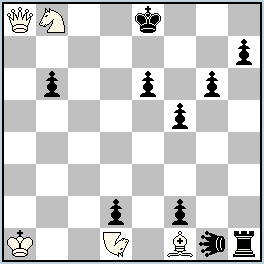 hs#4 2 solutions (5+10) |
No.200 Petko A. Petkov 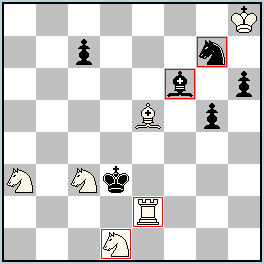 hs#4* (6+6) |
3rd Prize: No.29.1, Vysotska & Petkov, Latvia/Bulgaria.
A complex mix of unpins, masked batteries and promotions on 1st rank, leading to a critical wn/wb grimshaw on b5. The initial ws/wq preamble and the masked indirect leo battery on 2nd rank with dual avoidance in the black leo moves add more flourish. A clear improvement of No.29. Some dissenting voices about the black leo and it’s unpins.. Well.. the effects are real.. and one shouldn’t look at Caissa’s gifts too closely..!
I. 1.Sa6 +! Kd7 2.Qf8 LEh2! (2…LENg2?) 3.Na7 d1=N 4.Bb5 + Nxb5 #;
II. 1.Sc6 +! Kf7 2.Qh8 LEg2! (2.LEh2?) 3.Ba6 f1=B 4.Nb5 + Bxb5 #
4th Prize: No.200, Petkov, Bulgaria.
Complex battery and chameleon play. An apparent battery on f6-h8 is transformed into batteries on the h file and 8th rank. All shown in a light position.
Set-play: 1…g5-g4 2.cSd1-e3=cB cBf6-h4=cR 3.cBe3xh6=cR cSg7-h5=cB 4.cRh6-g6=cQ + cBh5xg6=cR #;
Real play: 1.cRe2-f2=cQ cBf6-d8=cR + 2.cQf2-f8=cS cSg7-e8=cB 3.cSf8-e6=cB cRd8-b8=cQ!! 4.cBe6-d7=cR + cBe8xd7=cR #
|
No.143 K. Seetharaman 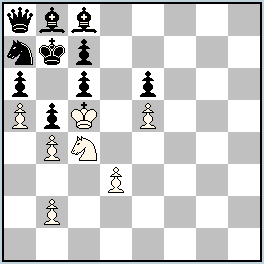 ser-h#16 (7+10) |
No.100 Julia Vysotska 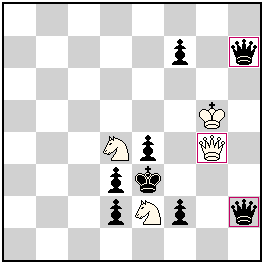 hs#3* (4+8) |
5th Prize: No.143, Seetharaman, India.
Typical SH# style switchbacks and BQ visits to all corners. Yes, maybe we could solve it faster..!
1.Bc8-d7 2.Sa7-c8 3.Sc8-b6 4.Bb8-a7 5.Qa8-h8 6.Qh8-h1 7.Qh1-a1 8.Qa1×a5 9.Qa5-a1 10.Qa1-h1 11.Qh1-h8 12.Qh8-a8 13.Ba7-b8 14.Sb6-c8 15.Sc8-a7 16.Bd7-c8 Sc4-a5 #
6th Prize: No.100, Vysotska, Latvia.
Mutual anti bristol style interferences between the black chameleon Qs on the h-file with each converting to knights to create a battery for the other. And with chameleon echo models and other matching moves.
Set-play: 1…CQh7-h4=CS 2.Kh5 f6 3.CQf5=CS + CSxf5=CB# (try: 1…Ch2-h6? 2.Kh5 f6 3.CQf5+ CQxf5=CS! no mate!);
Real-play: 1.CQe6=CS cQh2-h5=CS 2.Kh4 f5 3.CSf4=CB+ CSxf4=CB# (try: 1…CQh7-h3=CS? 2.Kh4 f5 3.CSf4+? CQxf4=CS! no mate!)
|
No.16 Petko A.Petkov
Bulgaria Julia’sFairies – 2012 7th Prize 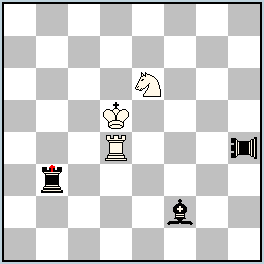 hs#4,5 2 solutions (3+3)
KoBul Kings Black Royal Piece Rb3 Black Rook-Locust h4 |
No.39 Peter Harris
South Africa
Julia’sFairies – 2012
Special Prize 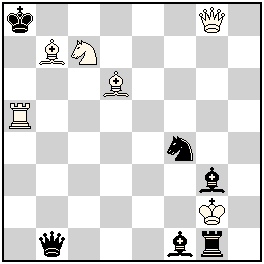 hs#3 b) d6↔g3 (6+6)
Anti-Circe
Isardam
|
7th Prize: No.16, Petkov, Bulgaria.
Aristocratic 6 piece miniature with monochrome echo of final ideal mate, fully utilising kobul condition and locust.
I. 1…Be3 2.Rg4 LRxg4-f4 [wrK=rR] 3.rRd1 Bc1 4.rRf1 rRb1 5.Sxf4 [brR=rLR] ! – zugzwang!→ 5…Bxf4 [wrR=rS] # (1…rRb1?);
II. 1…rRb8 2.Re4 Ba7 3.rKc4 LRxe4-d4 [wrK=rR] + 4.rRa4 rRa8 5.Sxd4 [brR=rLR]! – zugzwang→ 5…Bxd4 [wrR=rS] # (1.rRa3?)
Special Prize: No.39, Harris, South Africa.
A complex combination of two different fairy conditions.. Anti-Circe and Isardam.. with many interesting effects.
a) 1.Ra5-g5 Rg1-h1 2.Sc7-b5 Rh1-h2 3.Kg2×f1 [wKf1->e1] + Ka8×b7 [bKb7->e8] #;
b) 1.Bg3-f2 Sf4-e2 2.Qg8-b8 Bd6-f4 3.Kg2×g1 [wKg1->e1] + Ka8×b8 [bKb8->e8] #
H ONORABLE MENTIONS
|
No.128 Petko A.Petkov
hs#2,5 2 solutions (6+9) |
No.153.1 Nikola Predrag 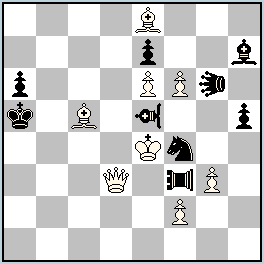 hs#3 2 solutions (8+9) |
1st Honorable Mention: No.128, Petkov, Bulgaria.
Matched openings of the doubly masked half battery b1-b8 with the DGs being fully utilised in both solutions. The way c7 and c8 is guarded and WB-b7 is prevented is very interesting.
I. 1…QGh4-c4 2.Sb2-a4 b5xa4 3.Bb4-c5+ b6xc5‡; II. 1…QGh5-c3 2.Bb4-a5 b6xa5 3.Sb2-c4+ b5xc4‡
2nd Honourable Mention: No.153.1, Predrag, Croatia.
Intricate Locust and Chinese line effects with orthogonal/diagonal echoes. I prefer this version over No.153, since the 3rd move tries here are better than the 1st move tries of 153.
I. 1.Qe3 LRxg3-h3 2.Kf3 LEg3 3.Qa3+ LExa3# (3.Qe1+? Lexe1+ 4.Be3!);
II. 1.Qd4 LBxf6-g7 2.Ke5 LEf6 3.Qa1+ LExa1# (3.Qd8+? LExd8+ 4.Bd4!)
|
No.99 Peter Harris
South Africa Julia’sFairies – 2012 3rd Honorable Mention 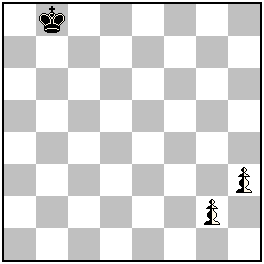 h#2 b) Kb8→a4 (0+1+2n) |
No.26.1 Petko A.Petkov, S.K. Balasubramanian & Pierre Tritten
Bulgaria / India / France Julia’sFairies – 2012 4th Honorable Mention 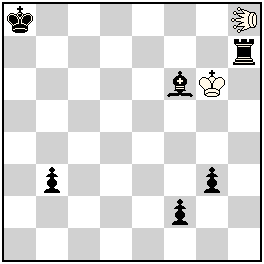 h#2 2 solutions (2+6)
White Locust h8
KoBul Kings
|
3rd Honourable Mention: No.99, Harris, South Africa.
Plenty of Neutral, Circe and Chameleon effects, leading to AUW with only 3 pieces. Reminiscent of Gandev’s works.
a) 1.nPh3×g2 [+nPa8=nB] nBa8×g2=nR [+nPe1=nS] 2.nSe1×g2=nB [+nRa7] nBg2-a8=nR #;
b) 1.nPh3×g2 [+nPg8=nQ] nQg8×g2=nS [+nPe1=nR] 2.nSg2×e1=nB [+nRb5] nBe1-a5=nR #
4th Honorable Mention: No.26.1, Tritten, Balasubramanian & Petkov, France/India/Bulgaria
France/India/Bulgaria. Harmonious and complex 4-corner play with outstanding economy.
I. 1.Rh2 Kxf6 (Ka8=rB) 2. rBg2 LOxh2-h1 (rB=rR) #; II. 1.Bb2 Kxh7 (Ka8=rR) 2.rRa2 LOxb2-a1 (rR=rB) #
|
No.150 Petko A.Petkov 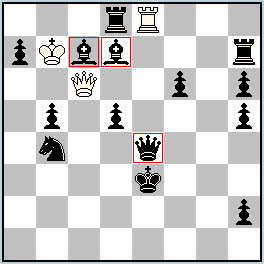 hs#3 2 solutions (3+14)
Anti-Andernach
Сhameleons: Bc7,Bd7,Qe4
|
No.2 K. Seetharaman 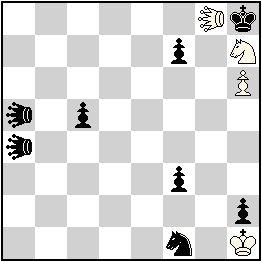 hs#2,5 b) LEg8->g7 (4+8)
LEOs: a4, a5, g8 |
5th Honorable Mention: No.150, Petkov, Bulgaria.
Half battery openings with Chameleon and Anti-Andernach effects.
I. 1.Qxc7 Кf3 2.Qxh2 CQf4 =wCS 3.CSxh5 = CB+ CBg4 =wCR#! – because of illegal self-checks not possible are the moves:
4. wCRg7=bCQ??; 4.wCBf7=bCR??; 4. Re7=bR??; 4.Qc7=bQ?? ;
II. 1.Qxd7 Kd4 2.Qxb5 CQg4 =wCS 3.CSxf6 = CB+ CBe5 =wCR#! – because of illegal self-checks not possible are the moves:
4. wCRe7=bCQ??; 4.wCBe7=bCR??; 4.wCBg7=bCR??;4. Re7=bR??; 4.Qd7=bQ??
6th Honorable Mention: No.2, Seetharaman, India.
The Black Leos have to avoid blocking a1-h8 or a8-h8. This results in Bristol style critical moves and long range White Anti-Battery formations.
a) 1….LEa2 2. LEa8 LE5a3! 3. Sf8+ LExa8#; b) 1….LEa7 2. LEa1 LE4a6! 3. Sf6+ LEna1#
|
No.70.1 Valerio Agostini & Petko A.Petkov 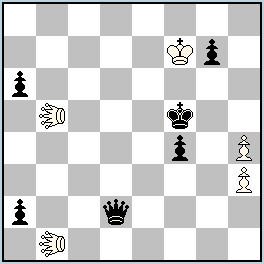 h#2,5 2 solutions (5+6)
Lions: b1, b5
|
No.118.1 Bosko Miloseski 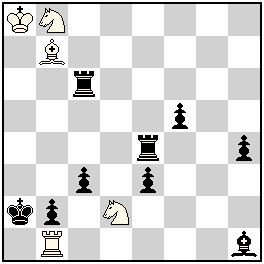
hs#3 2 solutions (5+9)
|
7th Honorable Mention: No.70.1, Agostini & Petkov, Italy/Bulgaria.
A delicate dance between the BQ and the W Lions.. with Li/Li batteries and other echoed strategy.
I. 1…LIb1-h7 2.Qd2-b2 (2.Qb4?) LIb5-b1 3.Db2-e5 LIb1-g6#; II. 1…LIb5-h5 2.Dd2-b4 (2.Qb2?) LIb1-b5 3.Db4-e4 LIb5-g5#
8th Honorable Mention: No.118.1, Miloseski, Macedonia.
Bi-colour Brunner-Turton with direct and masked pins of WB and WS.
I. 1.Rb1-g1 Rc6-h6 2.Rg1-g6 Re4-e8 3.Rg6-a6 + Rh6×a6 #; II. 1.Rb1-f1 Re4-g4 2.Rf1-f4 Rc6-c8 3.Rf4-a4 + Rg4×a4 #
|
No.176 Peter Harris 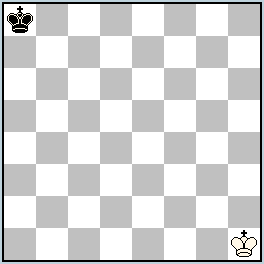
hs=5 (1+1)
b) +Black Grasshopper h7 Maximummer Sentinelles Pion Advers |
No.198 Ján Golha 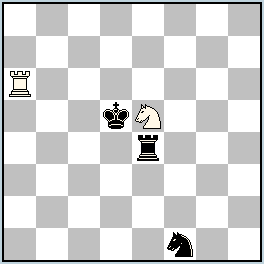
h=3 4 solutions (2+3)
Take & Make Circe Parrain |
9th Honorable Mention: No.176, Harris, South Africa.
3 promotions in each twin with interesting final stalemates.
a) 1.Kh1-h2 Ka8-b7 2.Kh2-g2[+bPh2] Kb7-a6[+wPb7] 3.b7-b8=Q h2-h1=B + 4.Kg2-h2[+bPg2] g2-g1=S 5.Qb8-g3 Bh1-a8 =;
b) 1.Kh1-h2 Gh7-h1[+wPh7] 2.h7-h8=Q + Ka8-b7 3.Qh8-b2 + Kb7-a6[+wPb7] 4.Qb2-a1[+bPb2] + b2×a1=R 5.b7-b8=G Ra1-g1 =
10th Honorable Mention: No.198, Golha, Slovakia.
4 fold stalemate echo with a fair amount of Take &Make and Circe-Parrain effects in each solution.
I. 1.Re4-e1 Ra6-a1 2.Kd5×e5-g6 Ra1×e1-b1 [+wSf5] 3.Kg6-h5 Rb1×f1-g3 =;
II. 1.Re4-a4 Ra6×a4-c4 2.Kd5×e5-f3 [+bRc2] Rc4×c2-e2 [+wSg3] 3.Kf3×e2-e1 Sg3×f1-e3 [+wRc2] =;
III. 1.Re4×e5-c6 Ra6×c6-c4 [+wSg3] 2.Kd5×c4-a4 Sg3-f5 [+wRb6] 3.Sf1-e3 Sf5×e3-c4 =;
IV. 1.Kd5×e5-f3 Ra6-a4 [+wSe3] 2.Kf3-f2 Se3×f1-g3 3.Kf2-g1 Ra4×e4-e2 =
|
No.144 Georgy Evseev & Lev Grolman 
h#3 3 solutions (1+0+3n)
Circe Parrain
Madrasi
|
No.213 Diyan Kostadinov 
h#2 b) nRa2->c4 (2+10+2n)
Anti Take & Make Take & Make |
11th Honorable Mention: No.144, Evseev & Grolman, Russia.
3 fold echo with excellent Neutral, Circe-Parrain and Madrasi effects in a Wenigsteiner.
I. 1.cxd3 Knf8(Bc3) 2.d2 Kng7 3.d1=Sn Snxb2‡;
II. 1.c3 Kng7 2.cxb2 Knh7(Bnc2) 3.b1=Qn Qnxc2‡;
III. 1.Bnc3 Knh7+ 2.cxd3 Knh8(Bd4) 3.d2 dxc3‡
12th Honorable Mention: No.213, Kostadinov, Bulgaria.
Complex combination of Neutral pieces and two varieties of Take & Make.. leading to mutual batteries and every move packing a punch.
a) 1.B×a2(nRf2, Be2) nB×d5(Rg5, nBf5)+ 2.nR×f5(nBb1, nRc2) nR×e2(Bh5, nRa6)#;
b) 1.B×c4(nRh4, Bg4) nR×g4(Bh5, nRe6)+ 2.nB×e6(nRb6, nBc6)+ nB×d5(Rg5, nBd3)#
C OMMENDATIONS
|
No.20 Alex Levit 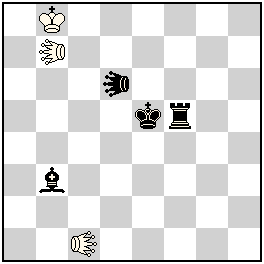
hs#3,5 2 solutions (3+4)
KoBul Kings
Locust c1 ;
Lions: b7,d6 |
No.172 Julia Vysotska 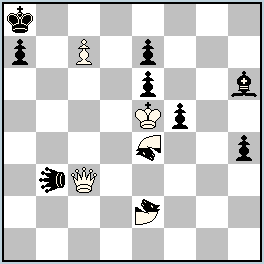
hs#3 b) nMAOe4->e3 (3+8+2n)
MAO e4, MOA e2 Lion b3 |
1st Commendation: No.20, Levit, Russia.
3 Kobul transforms in each solution plus tempo moves and orthogonal/diagonal echo in a miniature setting.
I. 1…Bb3-c4 2.Lc1×c4-c5 [brK=rB] rBe5-g7 3.Lc5×d6-e7 [brB=rLI] + Rf5-f7 4.rKb8-a7 ZZ rLIg7×e7 [wrK=rL] #
(5.Li×f7[brLI=rR]?? self-check);
II. 1…Rf5-g5 2.Lc1×g5-h6 [brK=rR] rRe5-e4 3.Lh6×d6-c6 [brR=rLI] + Bb3-d5 4.rKb8-a8 ZZ rLIe4×c6 [wrK=rL] # (5.Li×d5[brLI=rB]?? self-check)
2nd Commendation: No.172, Vysotska, Latvia.
Uncommon combination of Neutral Mao/Moa , each pinning the other while opening a battery.
a) 1.nMAe4-g5 LIb3-h3 2.nMOe2-f4 LIh3-h5 3.Qc3-f3 + nMAg5×f3 # (4.nMOf4xh5? – illegal self-check by nMAf3!);
b) 1.nMAe3-d5 Bh6-c1 2.nMOe2-d4 Bc1-b2 3.Qc3-c6 + nMOd4×c6 # (4.nMAd5-c3? – illegal self-check by nMOc6!)
|
No.116 Zoran Gavrilovski
Macedonia Julia’sFairies – 2012
3rd Commendation 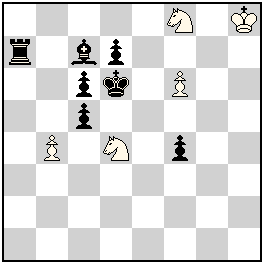
ser-h#7 b) Sf8→a6 (5+7)
|
No.67 K. Seetharaman
India (After Julia Vysotska) Julia’sFairies – 2012 4th Commendation 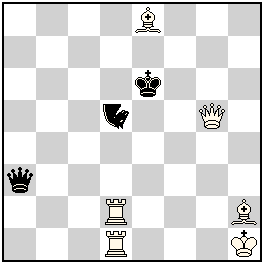
hs#3 2 solutions (6+3)
Nightrider d5
|
3rd Commendation: No.116, Gavrilovski, Macedonia.
In each phase, the BK opens, closes and again opens lines through d6, before returning there finally. Typical SH# motifs along with interchange of the 2nd and 5th moves.
a) 1.Kd5! [1.Ke5? … 4.Kd7??] 2.Be5 A 3.Kd6 4.Kc7 5.d5 B 6.Kd6 7.Rc7 Sf5#;
b) 1.Ke5! [1.Kd5? … 4.Kc7??] 2.d5 B 3.Kd6 4.Kd7 5.Be5 A 6.Kd6 7.Rd7 b:c5#
4th Commendation: No.67, Seetharaman(after Vysotska), India.
Mutual BQ/BN batteries in a light and perfect setting.
I. 1. Rd4 Qd3 2. Rg1 Nb4 3. Re4+ Qxe4#; II. 1. Rg2 Nb1 2. Rd7 Qa1 3. Re7+ Nxe7#
|
No.108.1 Semion Shifrin
Israel Julia’sFairies – 2012 5th Commendation 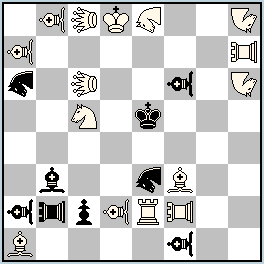
#2* AMU (15+9)
LEOs: c6, c8
PAOs: b2, f2, g7 VAOs: a2, a7, b8, d2, f1, f6 NAOs: a6, e3, e8 Nightriders: h6, h8 |
No.87 Dieter Müller, Franz Pachl & Sven Trommler
Germany Julia’sFairies – 2012 6th Commendation 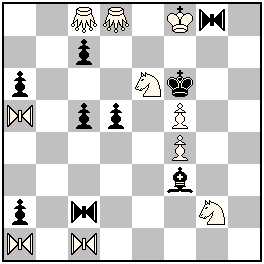
#2 v… (10+9)
Grasshoppers: c8, d8
Equihoppers: a1, a5, c1, c2, g8
|
5th Commendation: No.108.1, Shifrin, Israel.
Combination of Dombrovskis and multiple anti-battery mates on c7.
|
1…Bg8 a 2. PAc7# A 1. PAb7 ? ( 2. PAc7# A) 1…Bg8 a ! |
1. VAb6 ! ( 2. VA6c7# ) 1…Bg8 a 2. PAc7# A |
6th Commendation: No.87, Müller, Pachl & Trommler, Germany.
3-fold Dombrovskis using Equihopper specific effects.
|
1.Eqa1-a3? (2.Eqe7=A#) 1. – c4=a! 1.Sh4? (2.Gc6#) c4=a/d4=b/c6=c Eqe4 !!! |
1.Se3!! (2.Gc6#) c4=a/d4=b/c6=c |
|
No.119 Jean-Marc Loustau 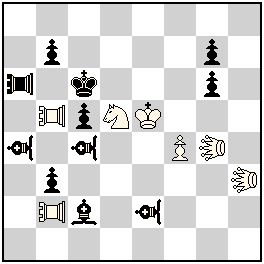
#2 (7+11)
LEOs: LEg4, LEh3
PAOs: PAa6, PAb2, PAb5
VAOs: VAa4, VAc4, VAe2
|
No.133 Franz Pachl 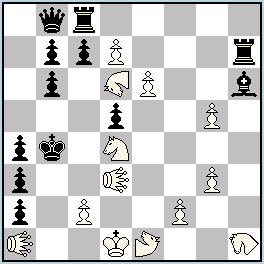
#2 (13+12)
PWC
Camel d6; Zebre e1; RAO h1
Double-Grasshopper a1,d3
|
7th Commendation: No.119, Loustau, France.
Typical Chinese specific mechanism to get a 2 phase/3 mate Shedey theme, with all mates by a single W Leo.
|
1 LEh7? threats 2 LExc4# A |
1.f5! threats 2 LExa4# B |
8th Commendation: No.133, Pachl, Germany.
4 mate Ukraine theme, using a known mechanism.
|
1.d8=Z? [2.Sb3# – A ] 1.d8=RA? [2. CAe3# – B ] |
1.d8=DG? [2.Zb3# – C ] 1.d8=CA! [2.c3# – D] |
|
No.195 Peter Harris
South Africa Julia’sFairies – 2012 9th Commendation 
h=3 b) white Bh8 (1+1)
Anti-Super-Circe Circe ; Sentinels |
No.157 Chris Feather
England Julia’sFairies – 2012 10th Commendation 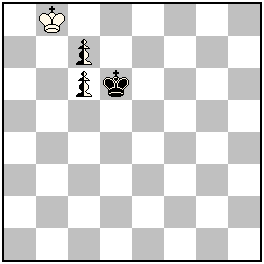
h#3 duplex (1+1+2n)
PWC
Take & Make
|
9th Commendation: No.195, Harris, South Africa.
A two piece setting leading to varied stalemate positions in different corners and all conditions being well used.
a) 1.Kf4-g3[+bPf4] Rh8-g8 + 2.Kg3-h2[+bPg3] Rg8×g3 [+bPg7][wRg3->f7] 3.Kh2-h1[+bPh2] Rf7×f4[wRf4->g6][+wPf7] =;
b) 1.Kf4-g5[+bPf4] Bh8-f6 + 2.Kg5×f6 [+wBc1][bKf6->h8][+bPg5] Bc1-e3 3.f4×e3 [+wBc1][bPe3->g8]
Bc1×g5 [+bPg7][wBg5->g6] =
10th Commendation: No.157, Feather, England.
Gandev style AUW in a Wenigsteiner with Neutral pawns and a new twist with Take & Make.
Black plays first: 1.Ke7 nPc8=nS+ 2.Kd8 Kxc8-d6[nSb8] 3.nSd7 nPxd7-f8=nR[nSc6]#;
White plays first: 1.nPc8=nB nBb7 2.nPxb7-g2[nBc6] nBa8 3.Kc8 nBxg2-g4[nPa8=nQ]#
|
No.134 Mario Parrinello
Italy Julia’sFairies – 2012 11th Commendation 
h#2 b) bRe4->e3 (9+10)
c) bRe4->f4
Chameleons: Qc7, Sc5, Sf5
|
No.151 Petko A. Petkov
Bulgaria Julia’sFairies – 2012 12th Commendation 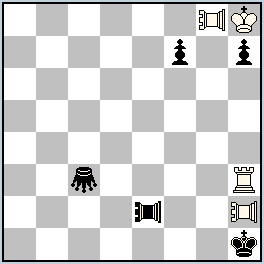
hs#3,5 3 solutions (4+5)
Grasshopper c3
PAOs: e2,g8,h2
|
11th Commendation: No.134, Parrinello, Italy.
Cyclic funktionwechsel(Zilahi) between 3 W Chameleons.
a) 1.gxf5 CSa6=CB 2.Ke3 CBd3=CR#; b) 1.Sxc7 CSg7=CB 2.Kf4 CBxf6=CR#; c) 1.Sxc5 CQb6=CS 2.Ke4 CSxd5=CB#
12th Commendation: No.151, Petkov, Bulgaria.
3 matching solutions with Black Pao/G dance and White R/Pao Bristol.
I.1…PAc2 2.Rh6 Gc1 3.PAh5 PAc7 4.PAhg5+ Gxh6#;
II.1…PAd2 2.Rh4 Ge1 3.PAh3 PAd7 4.PAhg3+ Gxh4#;
III. 1…PAe3 2.Rh5 Gf3 3.PAh4 PAe7 4.PAhg4+ Gxh5#
|
No.161 C.G.S.Narayanan
India Julia’sFairies – 2012 13th Commendation 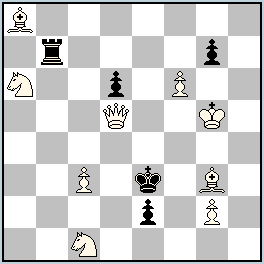
#2 (9+5)
Superguards
|
No.110.1 Mečislovas Rimkus & János Mikitovics
Lithuania / Hungary Julia’sFairies – 2012 14th Commendation 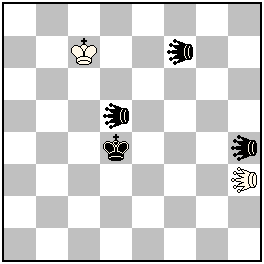
ser-h#10 (2+4)
b) DGh3→e6; c) Kc7→c2; d) Kc7→g7
Double Grasshoppers h3,h4,d5,f7
|
13th Commendation: No.161, Narayanan, India.
Superguards effects are used to produce a “Love Chase” reminiscent of Loyd’s famous example.
Key: 1. Be1 ! (2.Qe6 #) (2. Qd3, d4? Re7!)
1… Re7 2. Qe4 !# (2. Qe6? R:e6!)
1… Rb5! 2. Qc5! # (2.Qe4?)
1…Rb4! 2. Qd4!# (2. Qe4? Kd4!)
1…Rb2! 2. Qd2! #
14th Commendation: No.110.1, Rimkus & Mikitovics, Lithuania/Hungary.
4 BK in corner mates with Double Grasshoppers.
a) 1.Kd4-e5 2.Ke5-f6 3.DGh4-g7 4.DGf7-e6 5.DGd5-b7 6.DGe6-g8 7.Kf6-g6 8.Kg6-h7 9.Kh7-h8 10.DGb7-h7 Kc7-d7 #;
b) 1.DGh4-c8 2.Kd4-e4 3.DGd5-f8 4.Ke4-f3 5.DGf7-g2 6.DGf8-h2 7.Kf3-f2 8.Kf2-g1 9.Kg1-h1 10.DGc8-f6 Kc7-d6 #;
c) 1.DGf7-e4 2.DGd5-f5 3.Kd4-c5 4.Kc5-b6 5.DGh4-a7 6.DGe4-b7 7.Kb6-c7 8.Kc7-b8 9.Kb8-a8 10.DGf5-b8 Kc2-b3 #;
d) 1.Kd4-d3 2.DGf7-c2 3.DGd5-b2 4.Kd3-c4 5.DGc2-d5 6.DGd5-b1 7.Kc4-b3 8.Kb3-a2 9.Ka2-a1 10.DGh4-a2 Kg7-h7 #
|
No.117 Tibor Érsek & János Mikitovics
Hungary Julia’sFairies – 2012 15th Commendation 
ser-h=8 (8+6)
Anti-Circe
|
No.123 János Mikitovics
Hungary Julia’sFairies – 2012 16th Commendation 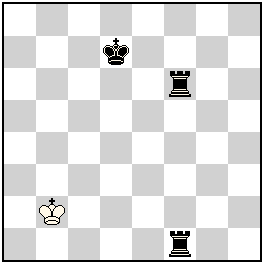
hr#2,5 3 solutions (7+2)
b) Kb2 ↔ Rf1 4 sol.
KoKo
|
15th Commendation: No.117, Érsek, Mikitovics, Hungary.
3 BB promotions, BR Rundlauf and self pins by returning BBs.
1.c2×b1=B[bBb1->c8] 2.Ra1×g1[bRg1->h8] 3.g2-g1=B 4.Bg1×f2[bBf2->f8] 5.Kh1×h2[bKh2->e8] 6.Rh8-h1 7.Rh1-a1 8.b2-b1=B Kd3-c2 =
16th Commendation: No.123, Mikitovics, Hungary.
7 fold echoes between the two twins.
a) I. 1…Rf1-a1 2.Kb2-a2 Rf6-c6 3.Ka2-b1 Rc6-c2 #; II. 1…Rf1-b1 2.Kb2-c2 Rf6-d6 3.Kc2-c1 Rd6-d2 #;
III. 1…Rf1-c1 2.Kb2-c2 Rf6-e6 3.Kc2-d1 Re6-e2 #
b) I. 1…Rb2-e2 + 2.Kf1-e1 Rf6-c6 3.Ke1-d1 Rc6-c1 #; II. 1…Rb2-f2 2.Kf1-e2 Rf6-d6 3.Ke2-e1 Rd6-d1 #;
III. 1…Rb2-g2 + 2.Kf1-g1 Rf6-e6 3.Kg1-f1 Re6-e1 #; IV. 1…Rf6-f2 2.Kf1-g2 Rf2-f1 + 3.Kg2-g1 Rb2-h2 #
|
No.114 Paul Răican
Romania Julia’sFairies – 2012 17th Commendation 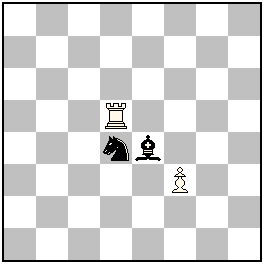
hs#5,5** 2 solutions (2+2)
Circe Parrain
Einstein Chess
Republican Chess Type 2
|
No.136 Michael Grushko
Israel Julia’sFairies – 2012 18th Commendation 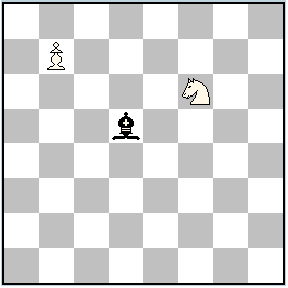
hs#9* (2+1)
PWC
Einstein Chess
Republican Chess Type 2
|
17th Commendation: No.114, Răican, Romania.
A potent brew of 3 varied conditions produces surprisingly different mates on far edges of the board.
Set-plays: I. 1… … 2.f3-f4 Sd4-b5=P 3.f4-f5 Be4×f5=R 4.Rd5×b5=Q [+wPd5] Rf5-f8=B [+bPb8] 5.d5-d6 Bf8×d6=R 6.Qb5-a5=R [+wPc6][+wbKa8] + Rd6×c6=Q [+wKa6] #;
II. 1… … 2.f3×e4=S Sd4-c2=P [+bBd2] 3.Se4×d2=B c2-c1 [+bBd1] 4.Bd2×c1=R Bd1-e2=S [+bPd2] 5.Rd5×d2=Q Se2×c1=B [+bPb1] 6.Qd2-h6=R [+wRg5][+wbKh3] + Bc1-f4=S [+wKh5] #;
Real plays: I. 1…Sd4-c6=P 2.f3×e4=S c6-c5 [+bBe3] 3.Se4×c5=B Be3×c5=R [+bPa7] 4.Rd5×c5=Q [+wBb5] a7-a6 [+bRc4] 5.Bb5×a6=R Rc4-d4=B [+bPb6] 6.Qc5-b4=R [+bKa2] + Bd4-c3=S [+wKa4] #;
II. 1…Be4×f3=R 2.Rd5×d4=Q [+wPf2] Rf3-g3=B [+bSe4] 3.Qd4-d6=R Bg3×d6=R 4.f2-f3 [+wRd7] Rd6×d7=Q 5.f3×e4=S [+wRc8] Qd7-f7=R [+bSg4] 6.Se4-f6=P [+bKf8] + Sg4×f6=B [+wKd8] #
18th Commendation: No.136, Grushko, Israel.
Two echoed ideal mates with lengthy sequences.
Set-play: 1…Bd5×b7=R [+wPd5] 2.d5-d6 Rb7-e7=B 3.d6×e7=S [+bBd6] Bd6×e7=R [+wSd6] 4.Sd6-f7=P Re7-e8=B 5.f7×e8=S [+bBf7] Bf7-h5=S 6.Sf6×h5=B [+bSf6] Sf6×e8=B [+wSf6] 7.Bh5×e8=R [+bBh5] Bh5×e8=R [+wRh5] 8.Sf6×e8=B [+bRf6] Rf6- g6=B 9.Be8×g6=R [+bBe8][+bKh8] + Be8-f7=S [+wKh6] #;
Real solution: 1.Sf6×d5=B [+bBf6] Bf6-e7=S 2.Bd5-e4=S Se7-c8=P 3.b7×c8=S [+bPb7] b7-b6 4.Sc8×b6=B [+bPc8] c8-c5 5.Bb6×c5=R [+bPb6] b6×c5=S [+wRb6] 6.Rb6- b1=B Sc5×e4=B [+wSc5] 7.Bb1×e4=R [+bBb1] Bb1×e4=R [+wRb1] 8.Sc5×e4=B [+bRc5] Rc5-c2=B 9.Be4×c2=R [+bBe4][+bKe1] + Be4-d3=S [+wKc1] #
Congratulations to the winners and to all participants!



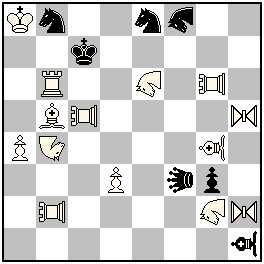
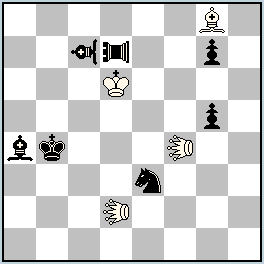
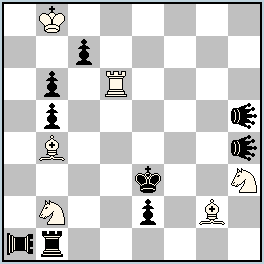
Dear Julia,
How pleased you must be to see the publication of the 2012 JF Awards.
The publication is the fruit of your original conception and of all your work since.
What a big job it was for Shankar Ram – and how well he has done it – and with such grace. Thank you Shankar.
And all who have any connection with JF must be delighted to see JV so prominent in the Awards.
So it is a happy occasion.
Bless you Julia,
Peter.
Congrats to Julia for the prizes and the other mentions. Many more I think deserve to be included, but the Judge obviously had a very tough criterion for selecting !
Thank you very much for this great job, Shankar!
217 problems to judge (with different conditions and different pieces) – a very difficult task that you have done.
I know enough judges who needs more time for less problems… 🙂
Thanks, Peter and Sven..!
Couldn’t have done it without the inspiration and energy provided by Julia..
@Sven :
Sometimes the judge delivers the award promptly enough, but the editor takes his time until he publishes it. Not everyone is as efficient as Julia, which is just another reason (among so many) why she is so praised.
I’m too much praised and so much touched with your mails and comments! Yesterday’s evening couldn’t find words to answer.. but felt so happy! Looking back, thinking about the first year of JF.. about my fears, and happiness, and hard work, and successful moments..
Dear Shankar, I believe it was a celebration day for you as well! [/img]
[/img]
One more time my gratitude to you, my congratulation about finished judging of the record high number of problems, and.. now I have to tell you that your Award has attracted to the site a record number of visitors! The site had 267 visits from 41 countries on the 1st of December (to compare: usually it’s about 100-130, another peaks were on 29-sep-2013 = 213; and 12-dec-2012 = 235)!
[img
From the evening of 30.Nov till the end of 01.Dec the Award was viewed 304 times, of which 238 are unique views!
I enjoyed our communication a lot! And now you’re very welcome at JF – to visit, to comment, to publish your problems! Be my guest!
I’d like to tell some words to Seetharaman. One of my first visitors, starting the very first day! And one of the most active commentators! One of those who comments not only when some improvements are to be done, but just to tell to the author, that he likes the problem! And also the first one (except myself 🙂 ) who has published the original problem at JF! The problem No.2, which is in the Award now! Dear Ram, thanks a lot for everything!
I feel I have to tell some good words to all of you! To Nikola Predrag for his instructive and also philosophical comments which made me think a lot. To Peter Harris for his support, ideas, originals, and also I’d like to remind you that it was Peter’s idea to create a list of published problems in a table format, and that most of the table for 2012 was prepared by Peter! To Juraj Lörinc and Eric Huber, who always can provide a link explaining any topic! To János Mikitovics – it was him who’s created a small favicon image for the site, the one you see in bookmarks or on the tab of your browser showing any JF’s page. To Diyan Kostadinov, who was the first who’s advertised my site on his own, and always announces my tournaments. And, of course, to Petko Petkov, who supports me all the time with his believe in me, with judging of thematic tournaments, with all contributions to the site, with advises, comments.. with his wish to see the site as the one of the best!
The success of Julia’sFairies is your success, my dear support-team, my dear visitors, authors, commentators!
THANK YOU VERY MUCH!
The greatness of this website comes from the various activities and contribution of its visitors. But the resulting sum of individual contributions is miraculously multiplied by a mighty cohesive factor. And that’s the determination, as well as the tenderness of our host. And in this occasion, the judge N.Shankar Ram shares the praises with Julia for an impressive and wonderful tourney. Thanks and cheers!
More than 200 problems looks impressive! Congratulations to all winners and many thanks to Julia and Shankar Ram for their work!